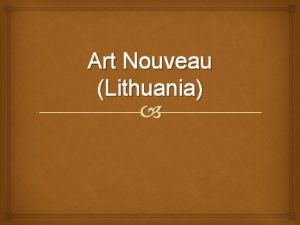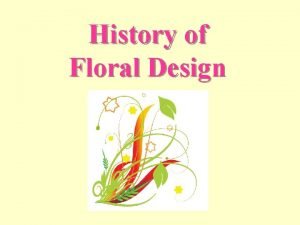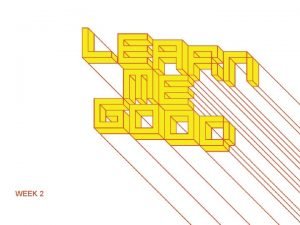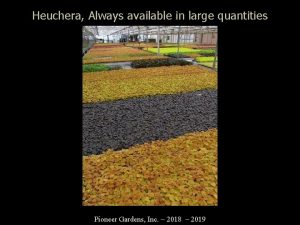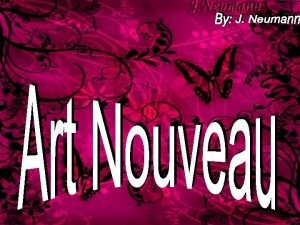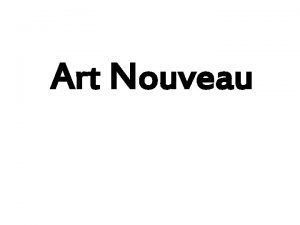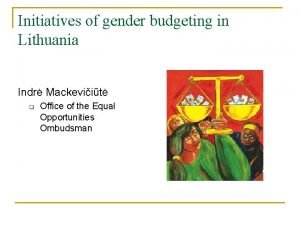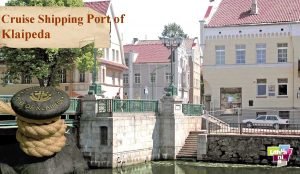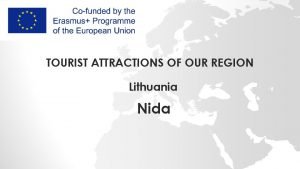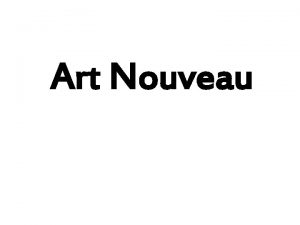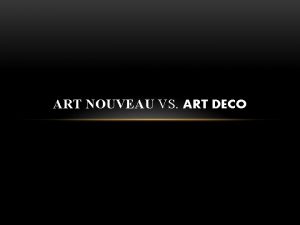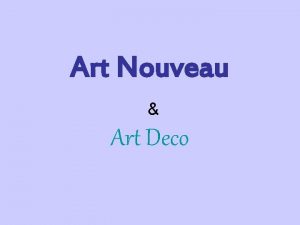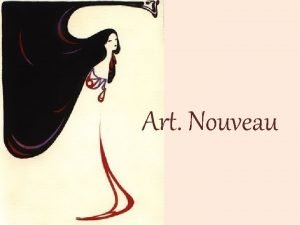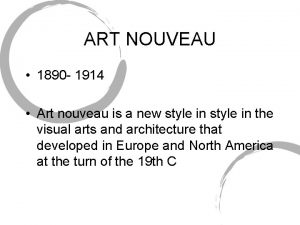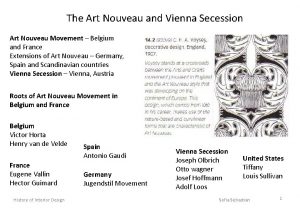Art Nouveau Lithuania Summary What is Art Nouveau




















- Slides: 20

Art Nouveau (Lithuania)

Summary What is Art Nouveau? What inspired Art Nouveau? Popularity of Art Nouveau buildings in Vilnius Mikalojus Konstantinas Čiurlionis Posthumous recognition

What is Art Nouveau? Art Nouveau is an international philosophy and style of art, architecture and applied art—especially the decorative arts—that were most popular during 1890– 1910. The name "Art Nouveau" is French for "new art". It is known also as Jugendstil, pronounced, German for "youth style", named after the magazine Jugend, which promoted it, as Modern in Russia, perhaps named after Parisian gallery "La Maison Moderne", as Secession in Austria. Hungary and its successor states after the Viennese group of artists, and, in Italy, as Stile Liberty from the department store in London, Liberty & Co. , which popularised the style.

What inspired Art Nouveau? A reaction to academic art of the 19 th century, it was inspired by natural forms and structures, not only in flowers and plants but also in curved lines. Architects tried to harmonize with the natural environment. It is also considered a philosophy of design of furniture, which was designed according to the whole building and made part of ordinary life.

Popularity of Art Nouveau was most popular in Europe, but its influence was global. Hence, it is known in various guises with frequent localised tendencies. Art Nouveau was also a style of distinct individuals such as Gustav Klimt, Charles Rennie Mackintosh, Alphonse Mucha, René Lalique, Antoni Gaudí and Louis Comfort Tiffany, each of whom interpreted it in their own manner. Although Art Nouveau was replaced by 20 th-century modernist styles, it is considered now as an important transition between the historicism of Neoclassicism and modernism. Furthermore, Art Nouveau monuments are now recognised by UNESCO with their World Heritage List as significant contributions to cultural heritage. [

Art Nouveau in Vilnius Academy of Science

The interior of Academy of Science

Art Nouveau building in Gedimino Avenue

Art Nouveau building in Gedimino Avenue

Little building in Gedimino Avenue

Some details

Mikalojus Konstantinas Čiurlionis Birth name Mikalojus Konstantinas Čiurlionis Born 22 September 1875 Senoji Varėna, Russian Empire Died 10 April 1911 (aged 35) Pustelnik (Marki), Russian Empire Nationality Lithuanian Field Painting, musical composition Training Warsaw Conservatory, Leipzig Conservatory, Warsaw School of Fine Arts Movement Symbolism; Art Nouveau

Mikalojus Konstantinas Čiurlionis also known as M. K. Čiurlionis (1875 – 1911) was a Lithuanian painter and composer. Čiurlionis contributed to symbolism and art nouveau and was representative of the fin de siècle epoch. During his short life he composed about 250 pieces of music and created about 300 paintings. The majority of his paintings are housed in the M. K. Čiurlionis National Art Museum in Kaunas, Lithuania. His works have had a profound influence on modern Lithuanian culture. The asteroid 2420 Čiurlionis is named after him. Čiurlionis felt that he was a synesthete; that is, he perceived colors and music simultaneously. Many of his paintings bear the names of musical pieces: sonatas, fugues, and preludes.

Rex The Creation of the World

Sonata of the Sea The Creation of the World X

Tranquility

Posthumous recognition In 1911 the first posthumous exhibition of Mikalojus Konstantinas Čiurlionis's art was held in Vilnius and Kaunas. During the same year an exhibition of his art was held in Moscow, and in 1912 his works were exhibited in St. Petersburg. In 1957 the Lithuanian community in Chicago opened the Čiurlionis Art Gallery, hosting collections of his works. In 1963 the Čiurlionis Memorial Museum was opened in Druskininkai, in the house where Čiurlionis and his family lived. This museum holds biographical documents as well as photographs and reproductions of the artist's works. The National M. K. Čiurlionis School of Art in Vilnius was named after him in 1965.

Posthumous recognition Čiurlionis's works have been displayed at international exhibitions in Japan, Germany, Spain, and elsewhere. His paintings were featured at "Visual Music" fest, an homage to synesthesia that included the works of Wassily Kandinsky, James Mc. Neill Whistler, and Paul Klee, at the Museum of Contemporary Art, Los Angeles in 2005.

National M. K. Čiurlionis School of Art Mikalojus Konstantinas Ciurlionis National Art Museum

Links http: //www. youtube. com/watch? v=0 x. Nzu. Hgge-s http: //www. youtube. com/watch? v=cqd 4 g 4 Gl_UU http: //www. mashpedia. com/Mikalojus_Konstantinas_ Čiurlionis
 Art nouveau conclusion
Art nouveau conclusion Egyptian floral arrangements
Egyptian floral arrangements William morris art nouveau
William morris art nouveau Art nouveau characteristics
Art nouveau characteristics Twilight heucherella
Twilight heucherella Art nouveau significado
Art nouveau significado Art nouveau font
Art nouveau font Famous places in lithuania
Famous places in lithuania Secondary school grading system
Secondary school grading system Lithuania business register
Lithuania business register Most popular sports in lithuania
Most popular sports in lithuania Dmc in vilnius
Dmc in vilnius Esn lithuania
Esn lithuania Budgeting in lithuania
Budgeting in lithuania Lithuania cruise port
Lithuania cruise port Lithuanian christmas dinner
Lithuanian christmas dinner Lithuanian countryside
Lithuanian countryside Lithuania jega results
Lithuania jega results Sundial on parnidis
Sundial on parnidis The voice of lithuania
The voice of lithuania Lithuania czech republic
Lithuania czech republic
